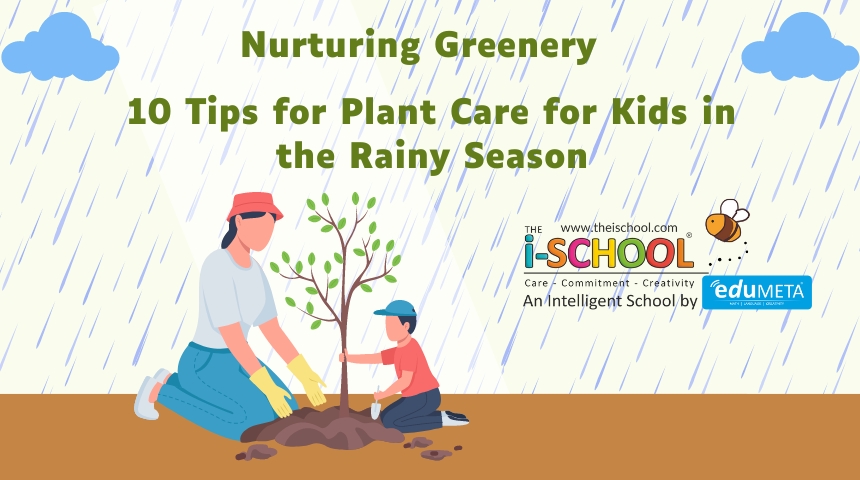Nurturing Greenery: 10 Tips for Plant Care for Kids in the Rainy Season

The rainy season brings a refreshing change and is a perfect time to teach children about plant care and the beauty of nature. While the increased rainfall can benefit plants, it also presents unique challenges that require special attention. At eduMETA THE i-SCHOOL, we believe in combining education with hands-on activities to foster a love for the environment. Here are ten essential tips for caring for plants during the rainy season, designed to involve kids and help them develop a green thumb.
1. Monitor Soil Moisture Levels
Why: Excessive rain can lead to waterlogged soil, which can be harmful to plants. Kids can learn to check soil moisture using their fingers or a simple moisture meter.
Tip: Teach children to feel the soil a few inches below the surface. If it feels wet, they should wait before watering again. If it feels dry, it may need a little extra water.
2. Ensure Proper Drainage
Why: Good drainage is crucial to prevent waterlogging and root rot. Kids can help by checking that pots and garden beds have adequate drainage holes.
Tip: Let children help with creating drainage by placing small stones or gravel at the bottom of pots or garden beds. This will help ensure excess water can escape.
3. Use Mulch Wisely
Why: Mulch helps retain soil moisture and prevents weeds. However, too much mulch can trap excess moisture around the plant roots.
Tip: Show kids how to apply a thin layer of mulch around the plants, leaving a small gap between the mulch and the plant stems. This helps in keeping the soil moist while preventing rot.
4. Prune Dead or Damaged Leaves
Why: Rain can cause leaves to become soggy and prone to fungal diseases. Pruning helps keep plants healthy and encourages new growth.
Tip: Teach children to use clean, sharp scissors to carefully remove any dead or damaged leaves. This helps prevent the spread of diseases and keeps the plant looking its best.
5. Protect Plants from Excessive Rain
Why: Heavy rain can damage plants and wash away soil nutrients. Kids can create simple protective measures to shield plants from intense rain.
Tip: Guide children in making makeshift rain covers using large plastic sheets or garden cloches to protect delicate plants during heavy downpours.
6. Observe for Pests and Diseases
Why: The rainy season can increase the likelihood of pests and fungal infections. Kids can learn to identify common issues and take preventive actions.
Tip: Encourage children to regularly inspect plants for signs of pests or diseases, such as discolored leaves or webbing. Show them how to gently remove pests or apply natural remedies.
7. Educate About Local Plants
Why: Different plants have varying needs, especially in different weather conditions. Understanding local plant species helps in providing proper care.
Tip: Teach kids about local plants that thrive during the rainy season and involve them in researching and planting these species. It enhances their knowledge and connection to local flora.
8. Create a Rainwater Collection System
Why: Rainwater is a valuable resource for plants and can be used effectively if collected. Kids can learn about sustainability by setting up a rainwater collection system.
Tip: Involve children in setting up rain barrels or containers to collect rainwater. They can use this water to nurture plants, teaching them about eco-friendly practices.
9. Practice Regular Weeding
Why: Weeds compete with plants for nutrients and water. Regular weeding ensures that plants have access to essential resources.
Tip: Show children how to identify and remove weeds from the garden. Encourage them to use garden gloves and tools to make the task easier and more enjoyable.
10. Engage in Fun Gardening Activities
Why: Making plant care fun helps children stay engaged and enthusiastic. Creative activities can make gardening an enjoyable learning experience.
Tip: Organize activities like making plant markers, decorating pots, or creating garden-themed crafts. These activities not only teach plant care but also add a creative element to the gardening experience.
Conclusion
Caring for plants during the rainy season offers a valuable opportunity for children to learn about nature, responsibility, and the importance of environmental stewardship. By following these ten tips, kids can effectively nurture their greenery and develop a lifelong appreciation for gardening. At eduMETA THE i-SCHOOL, we are dedicated to integrating practical learning experiences like these into our curriculum to inspire the next generation of eco-conscious individuals.
Encourage your child to embrace the rainy season with enthusiasm and curiosity, and watch them grow into confident and knowledgeable young gardeners. Together, we can nurture both plants and young minds, fostering a love for nature and a commitment to environmental care.
